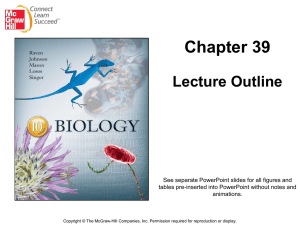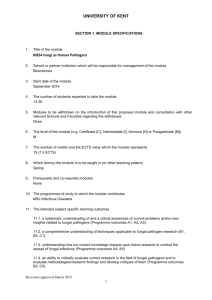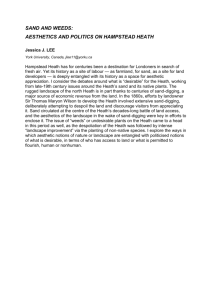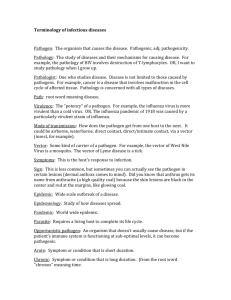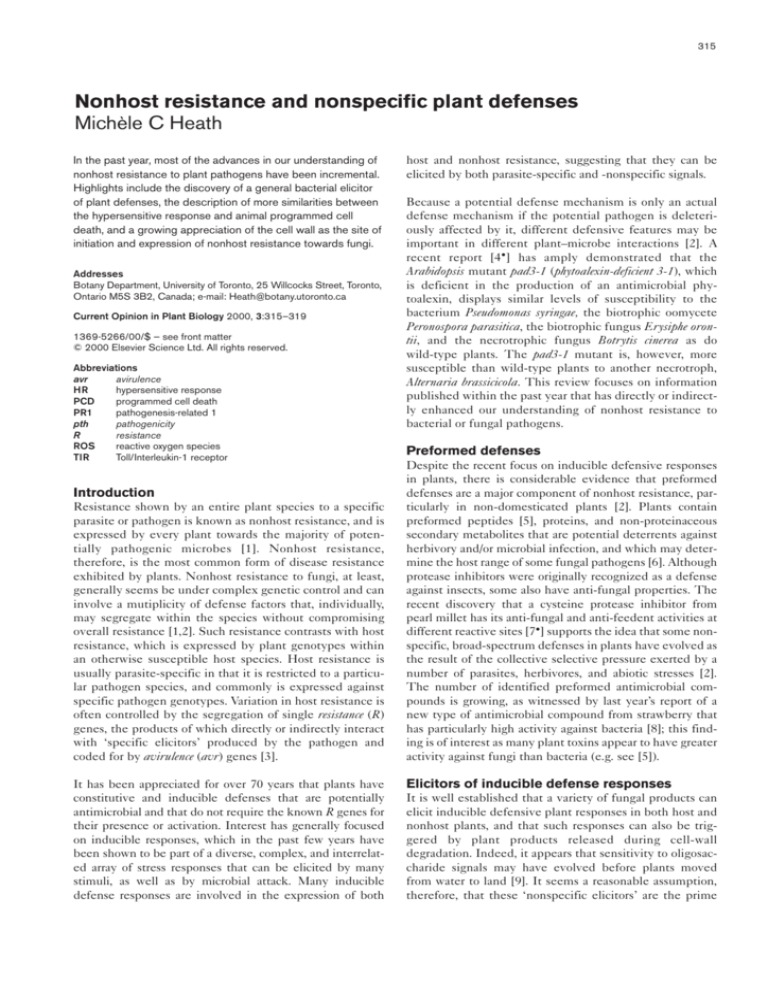
315
Nonhost resistance and nonspecific plant defenses
Michèle C Heath
In the past year, most of the advances in our understanding of
nonhost resistance to plant pathogens have been incremental.
Highlights include the discovery of a general bacterial elicitor
of plant defenses, the description of more similarities between
the hypersensitive response and animal programmed cell
death, and a growing appreciation of the cell wall as the site of
initiation and expression of nonhost resistance towards fungi.
Addresses
Botany Department, University of Toronto, 25 Willcocks Street, Toronto,
Ontario M5S 3B2, Canada; e-mail: Heath@botany.utoronto.ca
Current Opinion in Plant Biology 2000, 3:315–319
1369-5266/00/$ — see front matter
© 2000 Elsevier Science Ltd. All rights reserved.
Abbreviations
avr
avirulence
HR
hypersensitive response
PCD
programmed cell death
PR1
pathogenesis-related 1
pth
pathogenicity
R
resistance
ROS
reactive oxygen species
TIR
Toll/Interleukin-1 receptor
Introduction
Resistance shown by an entire plant species to a specific
parasite or pathogen is known as nonhost resistance, and is
expressed by every plant towards the majority of potentially pathogenic microbes [1]. Nonhost resistance,
therefore, is the most common form of disease resistance
exhibited by plants. Nonhost resistance to fungi, at least,
generally seems be under complex genetic control and can
involve a mutiplicity of defense factors that, individually,
may segregate within the species without compromising
overall resistance [1,2]. Such resistance contrasts with host
resistance, which is expressed by plant genotypes within
an otherwise susceptible host species. Host resistance is
usually parasite-specific in that it is restricted to a particular pathogen species, and commonly is expressed against
specific pathogen genotypes. Variation in host resistance is
often controlled by the segregation of single resistance (R)
genes, the products of which directly or indirectly interact
with ‘specific elicitors’ produced by the pathogen and
coded for by avirulence (avr) genes [3].
It has been appreciated for over 70 years that plants have
constitutive and inducible defenses that are potentially
antimicrobial and that do not require the known R genes for
their presence or activation. Interest has generally focused
on inducible responses, which in the past few years have
been shown to be part of a diverse, complex, and interrelated array of stress responses that can be elicited by many
stimuli, as well as by microbial attack. Many inducible
defense responses are involved in the expression of both
host and nonhost resistance, suggesting that they can be
elicited by both parasite-specific and -nonspecific signals.
Because a potential defense mechanism is only an actual
defense mechanism if the potential pathogen is deleteriously affected by it, different defensive features may be
important in different plant–microbe interactions [2]. A
recent report [4•] has amply demonstrated that the
Arabidopsis mutant pad3-1 (phytoalexin-deficient 3-1), which
is deficient in the production of an antimicrobial phytoalexin, displays similar levels of susceptibility to the
bacterium Pseudomonas syringae, the biotrophic oomycete
Peronospora parasitica, the biotrophic fungus Erysiphe orontii, and the necrotrophic fungus Botrytis cinerea as do
wild-type plants. The pad3-1 mutant is, however, more
susceptible than wild-type plants to another necrotroph,
Alternaria brassicicola. This review focuses on information
published within the past year that has directly or indirectly enhanced our understanding of nonhost resistance to
bacterial or fungal pathogens.
Preformed defenses
Despite the recent focus on inducible defensive responses
in plants, there is considerable evidence that preformed
defenses are a major component of nonhost resistance, particularly in non-domesticated plants [2]. Plants contain
preformed peptides [5], proteins, and non-proteinaceous
secondary metabolites that are potential deterrents against
herbivory and/or microbial infection, and which may determine the host range of some fungal pathogens [6]. Although
protease inhibitors were originally recognized as a defense
against insects, some also have anti-fungal properties. The
recent discovery that a cysteine protease inhibitor from
pearl millet has its anti-fungal and anti-feedent activities at
different reactive sites [7•] supports the idea that some nonspecific, broad-spectrum defenses in plants have evolved as
the result of the collective selective pressure exerted by a
number of parasites, herbivores, and abiotic stresses [2].
The number of identified preformed antimicrobial compounds is growing, as witnessed by last year’s report of a
new type of antimicrobial compound from strawberry that
has particularly high activity against bacteria [8]; this finding is of interest as many plant toxins appear to have greater
activity against fungi than bacteria (e.g. see [5]).
Elicitors of inducible defense responses
It is well established that a variety of fungal products can
elicit inducible defensive plant responses in both host and
nonhost plants, and that such responses can also be triggered by plant products released during cell-wall
degradation. Indeed, it appears that sensitivity to oligosaccharide signals may have evolved before plants moved
from water to land [9]. It seems a reasonable assumption,
therefore, that these ‘nonspecific elicitors’ are the prime
316
Biotic interactions
inducers of defense responses in nonhost plant–pathogen
interactions. New experimental evidence suggests that
cryptogein, one of a family of proteinaceous elicitors produced by Phytophthora species, has binding sites on cells
from both plant species that do and that do not defensively respond to the elicitor; this raises important questions
about receptor and signal pathway differences between
species [10••]. In contrast, a recent study involving elicitors
from yeast and commercial enzyme preparations used to
make plant protoplasts suggests that these elicitors directly interacted with lipid bilayers and formed
large-conductance pores [11•]. The fact that some elicitors
may not require a receptor-based mechanism for their
activity is an important revelation that should influence
subsequent studies of elicitor signaling.
Specific and nonspecific elicitors seem to trigger signal
transduction cascades involving protein kinases, elements
of the mitogen-activated protein (MAP) kinase pathway,
and protein phosphatases [12,13]. Details of how elicitor
signaling may lead to defense gene activation in nonhosts
has recently been demonstrated for the oligopeptide elicitor from Phytophthora sojae interacting with parsley leaves
and cells. Eulgem et al. [14•] report the cloning of WRKY1,
a gene encoding a nucleus-located zinc-finger-type transcription factor, and show that a novel arrangement of
palindromically positioned W boxes functions as a rapidacting elicitor-response element that results in the
expression of the gene. The WRKY1 transcription factor,
perhaps activated by phosphorylation, binds to the W
boxes within promotors of both its own and the PR1
(pathogenesis-related 1) target gene.
Nonspecific elicitors have been isolated with ease from
fungi. Until recently, however, the only known equivalent
elicitors from bacteria have been the cell-death-eliciting
harpins, heat-stable proteins encoded by members of the
hrp (hypersensitive response pathogenicity) gene cluster of
some Gram-negative bacteria [13]. An exciting new discovery, therefore, is that some plant cell cultures respond
to a conserved domain of flagellin, a component of the bacterial flagellum, with ion fluxes and other defensive
responses [15••]. This represents the first example of a
general bacterial elicitor, and its role in host-species specificity is further indicated by the fact that the corresponding
flagellin domains of bacteria that have highly intimate
associations with plants (e.g. Agrobacterium tumefaciens and
Rhizobium meliloti) are inactive. Interestingly, one
Arabidopsis ecotype, Ws-0, is insensitive to flagellin.
Crosses involving this ecotype have revealed a dominant
locus, FLS-1 (flagellin sensitive-1) that is important for the
perception of the flagellin signal [16••].
The hypersensitive response
The most common expression of host resistance, and a
frequent expression of nonhost resistance, is the hypersensitive response (HR), a rapid death of cells at the infection
site that is associated with pathogen limitation as well as
with defense gene activation [17]. Some of the avr genes
that control the HR response to bacterial pathogens in
resistant hosts also seem to act as pathogenicity (pth) genes
in susceptible plants. Gabriel [18•] has recently argued
that, because of horizontal gene transfer between bacteria,
some avr genes may be maladapted pth genes that ‘inadvertently’ elicit an HR in host and nonhost plants. Such a
situation seems particularly likely if the nonhosts have
R-gene products with which avr-gene products can interact [19]. Whether all examples of the HR in nonhost
interactions with bacteria are caused by avr gene action is
uncertain, and the roles of harpins and bacterial flagellin as
nonspecific elicitors of the HR remain to be determined.
Plant cells commonly (but not always) respond to elicitors or
microbial pathogens with an ‘oxidative burst’ during which
reactive oxygen species (ROS) are generated, usually extracellularly [20]. Although the common assumption that ROS
universally mediate hypersensitive cell death is beginning
to be questioned [20,21], there is new evidence for the role
of ROS in the hypersensitive cell death of plants showing
nonhost resistance to bacteria. Mittler et al. [22•] found that
transgenic tobacco plants expressing antisense RNA for the
ROS scavengers cytosolic ascorbate peroxidase or catalase
exhibited ion leakage in response to smaller numbers of a
bacterial pathogen of bean than did control plants; enhancing or suppressing ROS-scavenging mechanisms using high
oxygen pressure (either before or after inoculation) correspondingly reduced or enhanced cell death.
Hypersensitive cell death is now almost universally accepted as a form of programmed cell death (PCD), and the past
few years have seen a plethora of studies investigating
PCD in plants. Although key genes regulating apoptosis (a
form of mammalian PCD) do not appear to have homologs
in plants [21], there appear to be a growing number of
functional similarities between animal PCD, plant PCD,
and hypersensitive cell death (e.g. see [23,24]). Recent
papers of special interest report that the overexpression of
mammalian and nematode PCD suppressor genes in
tobacco plants reduced host hypersensitive cell death
induced by viral infection [25•]; likewise a death-promoting member of the same gene family triggered cell death
when expressed in plants using a tobacco mosaic virus vector [26•]. The release of mitochondrial cytochrome c is
critical for some forms of animal apoptosis, and recent
papers have demonstrated apoptosis-like effects of
cytochrome c both in plant protoplasts [27] and in mouse
liver nuclei bathed in the cytosol of carrot cells [28]. The
release of cytochrome c during heat-induced PCD in
cucumber plants has also been reported [29]. It may, therefore, be significant that the bacterial death-elicitor harpin
can reduce the capacity of mitochondrial cytochrome pathway electron transport [30].
Genes and genetic engineering
The common themes found in defense signaling in plants
were illustrated recently by the finding that a gene
Nonhost resistance and nonspecific plant defenses Heath
expressed in nonhost resistant marigold roots that were
exposed to the vascular plant parasite Striga asiatica
encodes a predicted cytoplasmic protein containing a TIR
(Toll/Interleukin-1 receptor)-like domain. This domain is
found in some R genes that control host resistance to
microbial pathogens, although the marigold protein lacks a
nucleotide-binding sequence that is found in such genes
[31]. The TIR motif appears to be evolutionarily ancient
[32] and, as some R genes of flax differ only in their TIR
region, may be involved in pathogen recognition [33].
Because of the durability of nonhost resistance over time
(pathogens have rarely altered their host species range over
recorded history), it is commonly speculated that nonhost
resistance could be exploited by plants breeders seeking to
improve disease resistance within host species [1]. The
overproduction of single nonspecific defense components
in transgenic plants has been attempted with various
degrees of success [34]. In one of the newest approaches,
broad-spectrum disease resistance has been generated in
transgenic tobacco by the introduction of an elicitin gene
coupled to a pathogen-inducible promoter [35].
Resistance mechanisms
Despite all the information described above, research in
the past year has added very little to our sparse knowledge
of the actual mechanisms of nonhost resistance. For bacteria that are experimentally introduced into plant tissue or
added to cell cultures, data generally suggest that defense
gene activation may be more important than hypersensitive cell death in inhibiting pathogen growth (e.g. see
[36]). This conclusion is supported by a recent study of
nonhost resistance expressed prior to plant cell death [37].
Unlike bacteria, fungal attack is usually initiated from
spores on external plant surfaces. Despite the apparent
importance of the HR in the nonhost resistance of
Nicotiana spp. to the oomycete Phytophthora [38] and the
fact that successful fungal penetration of nonhost cells
always induces an HR, nonhost resistance to fungi often
does not involve cell death. Instead, nonhost resistance can
be expressed prior to fungal entry into cells as mis-cues
from the plant surface, or as inhibition within intercellular
spaces following stomatal entry [39], or as growth restriction within cell walls [40].
For fungi that try to penetrate directly into epidermal cells,
considerable evidence points to the cell wall as a primary site
of nonhost resistance expression [41]. Indeed, recent studies
suggest that the infection outcome in both host and nonhost
plants may be determined while the fungus is growing within the cell wall [42,43]. Wall-associated defenses include the
peroxidative cross-linking of phenolic compounds fueled by
ROS generation [44], and the deposition of other substances
such as silica [40] and callose-containing papillae, which
combine to produce physical barriers to infection. The elicitors of these responses may be cell-wall components that are
released as the fungus digests its way through the wall [45]
and/or physical damage [46]. A new example of nonhost
317
resistance expressed during wall penetration comes from a
comparison of host and nonhost resistance in sorghum [47•].
In the nonhost interaction, the fungus does not successfully
breach the cell wall apparently because of the earlier transcriptional activation of PR-10 and chalcone synthase, and
the earlier accumulation of phytoalexins, than is the case in
the host interaction.
There is plenty of evidence to show that unless a pathogen
suppresses them, non-specific wall-associated defense
responses are triggered in host as well as nonhost plants. In
red onion epidermal cells resisting infection by Botrytis
allii, phenolic compounds and peroxidase activity increase
at infection sites in association with polarization of the
actin cytoskeleton [48•]. The latter observation supports a
general role for the actin cytoskeleton in the expression of
wall-associated defense responses. Additional evidence of
this role is provided by the increase in successful wall penetration caused by antimicrofilament agents in a number of
nonhost interactions [49].
An important new revelation is that nonhost wall-associated
responses to the fungi Uromyces vignae and Erysiphe
cichoracearum are dependent not only on the actin cytoskeleton but also on the adhesion of the plasma membrane to the
plant cell wall (DG Mellersh, MC Heath, unpublished
data). This adhesion can be eliminated by peptides containing an RGD (i.e. Arg–Gly–Asp) motif, indicating some
similarity between plant plasma-membrane–cell-wall interactions and those involved in the animal integrin-mediated
communication system between the cytoskeleton and the
extracellular matrix. E. cichoracearum also induces an RGDinsensitive increase in plasma-membrane–cell-wall
adhesion in nonhost plants (DG Mellersh, MC Heath,
unpublished data), suggesting the existence of multiple
plasma-membrane–cell-wall interacting molecules of different functions in plants. Significantly, a cytoplasmic
serine/threonine kinase that spans the plasma membrane
and binds tightly to the cell wall has been reported and is
encoded by the gene Wak1 (wall-associated receptor kinase 1)
in Arabidopsis. The expression of this gene is induced by
compatible bacterial infection [50]. The data from U. vignae
suggests that this fungus locally eliminates the adhesion of
the plasma membrane and the cell wall in its host plant as a
mechanism of eliminating wall-associated defenses
(DG Mellersh, MC Heath, unpublished data).
Conclusions
The past year has seen a steady increase in our knowledge
of the nature, elicitation, and regulation of microbial
defenses in plants, and much of it is applicable to our
understanding of nonhost resistance. Nevertheless,
unequivocal identification of features that actually stop
pathogen growth in a given nonhost plant is still rare (as it
is for host resistance). For fungal pathogens that attempt to
penetrate cells, recent data support the idea that highly
localized responses within the cell wall and early signaling
events play a primary role in nonhost resistance.
318
Biotic interactions
References and recommended reading
Papers of particular interest, published within the annual period of review,
have been highlighted as:
• of special interest
•• of outstanding interest
1.
Heath MC: Implications of nonhost resistance for understanding
host–parasite interactions. In Genetic Basis of Biochemical
Mechanisms of Plant Disease. Edited by Groth JV, Bushnell WR.
St Paul: APS Press; 1985:25-42.
2.
Heath MC: Evolution of plant resistance and susceptibility to
fungal parasites. In The Mycota V, Part B, Plant Relationships.
Edited by Carroll GC, Tudzynski P. Berlin: Springer; 1997:257-276.
3.
Hammond-Kosack KE, Jones JDG: Plant disease resistance genes.
Annu Rev Plant Physiol Plant Mol Biol 1997, 48:575-607.
4.
•
Thomma BPHJ, Nelissen I, Eggermont K, Broekaert WF: Deficiency
in phytoalexin production causes enhanced susceptibility of
Arabidopsis thaliana to the fungus Alternaria brassicicola. Plant J
1999, 19:163-171.
The authors report that a phytoalexin-deficient mutant of Arabidopsis was more
susceptible to one necrotrophic fungal pathogen than another. The work provides rare proof that a nonspecific defense mechanism can act as a resistance
mechanism in vivo, and that it acts differentially on different pathogens.
5.
Broekaert WF, Terras FRG, Cammue BPA, Osborn RW: Plant
defensins: novel antimicrobial peptides as components of the
host defense system. Plant Physiol 1995, 108:1353-1358.
6.
Morrisey JP, Osbourn AE: Fungal resistance to plant antibiotics as
a mechanism of pathogenesis. Microbiol Mol Biol Rev 1999,
63:708-724.
7.
•
Joshi BN, Sainani MN, Bastawade B, Deshpande VV, Gupta VS,
Ranjekar PK: Pearl millet cysteine protease inhibitor. Evidence for
the presence of two distinct sites responsible for anti-fungal and
anti-feedent activities. Eur J Biochem 1999, 265:556-563.
The authors show that modifying different amino acids of the cysteine
protease inhibitor independently abolished or enhanced the anti-fungal or
protease inhibitory activity of the protein. This observation supports the concept that single nonspecific plant defenses may have a multiplicity of defensive functions and be subject to multiple selective pressures.
8.
Filippone MP, Ricci JD, de Marchese AM, Farías RN, Castagnaro A:
Isolation and purification of a 316 Da preformed compound from
strawberry (Fragaria ananassa) leaves active against plant
pathogens. FEBS Lett 1999, 459:115-118.
9.
Potin P, Bouarab K, Küpper F, Kloareg B: Oligosaccharide
recognition signals and defence reactions in marine
plant–microbe interactions. Curr Opin Microbiol 1999, 2:276-283.
10. Bourque S, Binet M-N, Ponshet M, Pugin A, Lebrun-Garcia A:
•• Characterization of the cryptogein binding sites on plant plasma
membranes. J Biol Chem 1999, 274:34699-34705.
Biochemical characterization, radiation inactivation experiments, and covalent binding of elicitin to binding sites on plasma membranes were used to
identify a glycoprotein-binding site on the plasma membranes of tobacco
plants that were sensitive to the elicitor. They were also used to demonstrate
elicitor-binding sites on the plasma membranes of Acer and Arabidopsis
cells that were insensitive to the elicitor. These results suggest that binding
sites for elicitors may be conserved among different plant species, irrespective of whether the plant cell shows a typical defense response.
11. Klüsener B, Weiler EW: Pore-forming properties of elicitors of
•
plant defense reactions and cellulolytic enzymes. FEBS Lett 1999,
459:263-266.
This paper reports that an elicitor from yeast and several commercial cellulolytic enzymes contain components that cause transmembrane ion fluxes in
artificial lipid bilayers. The authors raise the possibility that some nonspecific elicitors may not require a receptor-based mechanism for their activity.
12. Desikan R, Clarke A, Atherfold P, Hancock JT, Neill SJ: Harpin
induced mitogen activated protein kinase activity during defence
responses in Arabidopsis thaliana suspension cultures. Planta
1999, 210:97-103.
13. Nürnberger T: Signal perception in plant pathogen defense. Cell
Mol Life Sci 1999, 55:167-182.
14. Eulgem T, Rushton PJ, Schmelzer E, Hahlbrock K, Somssich IE: Early
•
nuclear events in plant defence signalling: rapid gene activation
by WRKY transcription factors. EMBO J 1999, 18:4689-4699.
Using in situ RNA hybridizations and transient expression studies, the parsley transcriptional activator WRKY1 was shown to mediate fungal elicitorinduced gene expression by binding to W-box elements, as well as binding
to a specific arrangement of W-box elements in the WRKY1 promotor itself.
This is the first in vivo functional characterization of the regulation of part of
a nonspecific elicitor-induced gene activation cascade.
15. Felix G, Duran JD, Volko S, Boller T: Plants have a sensitive
•• perception system for the most conserved domain of bacterial
flagellin. Plant J 1999, 18:265-276.
Synthetic peptides comprising 15–22 amino acids of the most highly conserved domain within the amino terminus of eubacterial flagellin were
shown to act as elicitors of defense responses in the cells of several plant
species when present in nanomolar concentrations. This is the first report
of a general bacterial component acting as a nonspecific elicitor of defense
responses in plants.
16. Gómez-Gómez L, Felix G, Boller T: A single locus determines the
•• sensitivity to bacterial flagellin in Arabidopsis thaliana. Plant J
1999, 18:277-284.
Crosses between Arabidopsis ecotypes that are, or are not, sensitive to peptides corresponding to a conserved domain of eubacterial flagellin revealed
that a dominant locus is responsible for sensitivity to this peptide. This locus
maps to a chromosome region that contains a cluster of R genes, raising the
possibility that nonspecific elicitors can be perceived by a recognition
process similar to that involved in host resistance.
17.
Goodman RN, Novacky AJ: The Hypersensitive Reaction in Plants to
Pathogens. St Paul: APS Press; 1994.
18. Gabriel DW: Why do pathogens carry avirulence genes? Physiol
•
Mol Plant Pathol 1999, 55:205-214.
This paper reviews evidence that supports the hypothesis that because of
horizontal gene transfer, bacterial avr genes may be maladapted pathogenicity genes in situations (host or nonhost) in which their function is gratuitous or detrimental.
19. Heath MC: The role of gene-for-gene interactions in the
determination of host species specificity. Phytopathology 1991,
82:127-130.
20. Bolwell GP: Role of active oxygen species and NO in plant
defence responses. Curr Opin Plant Biol 1999, 2:287-294.
21. Heath MC: Apoptosis, programmed cell death and the
hypersensitive response. Eur J Plant Pathol 1998, 104:117-124.
22. Mittler R, Herr EH, Orvar BL, van Camp W, Willekens H, Inzé D,
•
Ellis BE: Transgenic tobacco plants with reduced capability to
detoxify reactive oxygen intermediates are hyperresponsive to
pathogen infection. Proc Natl Acad Sci USA 1999,
96:14165-14170.
Ion leakage was examined in plants treated with high oxygen pressure and
in transgenic tobacco plants expressing antisense RNA for ascorbate peroxidase or catalase; plants were inoculated with a bacterial pathogen of
beans. This is one of the few in planta demonstrations of a role for ROS in
the expression of a nonhost hypersensitive response.
23. D’Silva I, Poirier GG, Heath MC: Activation of cysteine proteases in
cowpea plants during the hypersensitive response — a form of
programmed cell death. Exp Cell Res 1998, 245:389-399.
24. del Pozo O, Lam E: Caspases and programmed cell death in the
hypersensitive response of plants to pathogens. Curr Biol 1998,
8:1129-1132.
25. Mitsuhara I, Malik KA, Miura M, Ohashi Y: Animal cell-death
•
suppressors Bcl-xL and Ced-9 inhibit cell death in tobacco plants.
Curr Biol 1999, 9:775-778.
The authors report that the expression of a mammalian or a nematode suppressor of programmed cell death in tobacco plants results in reduced cell
death in response to UV-B irradiation, paraquat treatment, or virus infection.
This is one of a number of reports published in 1999 suggesting that components of the programmed cell death in animals may function in plant cells.
These reports also suggest that the hypersensitive response seen in examples of both host and nonhost resistance to microbial pathogens may be regulated in a similar manner to death caused by abiotic stresses.
26. Lacomme C, Santa Cruz S: Bax-induced cell death in tobacco is
•
similar to the hypersensitive response. Proc Natl Acad Sci USA
1999, 96:7956-7961.
It is shown that the expression of a death-promoting mammalian gene triggers cell death and the accumulation of the defense-associated protein PR1
when expressed in tobacco from a virus vector. The hypothesis that the gene
activates an endogenous cell-death program is supported by the fact that
this death is blocked by a protein phosphatase inhibitor, as is virus-induced
hypersensitive cell death.
27.
Sun Y-L, Zhao Y, Liu C-X, Zhai Z-H: Cytochrome c can induce
programmed cell death in plant cells. Acta Bot Sin 1999, 41:379-383.
Nonhost resistance and nonspecific plant defenses Heath
319
28. Zhao Y, Jiang Z-F, Sun Y-L, Zhai Z-H: Apoptosis of mouse liver
nuclei induced in the cytosol of carrot cells. FEBS Lett 1999,
448:197-200.
42. Xu H, Heath MC: Role of calcium in signal transduction during the
hypersensitive response caused by basidiospore-derived
infection of the cowpea rust fungus. Plant Cell 1998, 10:585-597.
29. Balk J, Leaver CJ, McCabe PF: Translocation of cytochrome c from the
mitochondria to the cytosol occurs during heat-induced programmed
cell death in cucumber plants. FEBS Lett 1999, 463:151-154.
43. Mould MJR, Heath MC: Ultrastructural evidence of differential
changes in transcription, translation, and cortical microtubules
during in planta penetration of cells resistant or susceptible to
rust infection. Physiol Mol Plant Pathol 1999, 55:225-236.
30. Xie Z, Chen Z: Harpin-induced hypersensitive cell death is
associated with altered mitochondrial functions in tobacco cells.
Mol Plant Microbe Interact 2000, 13:183-190.
31. Gowda BS, Riopel JL, Timko MP: NRSA-1: a resistance gene
homolog expressed in roots of non-host plants following
parasitism by Striga asiatica (witchweed). Plant J 1999, 20:217-230.
32. Meyers BC, Dickerman AW, Michelmore RW, Sivaramakrishnan S,
Sobral BW, Young ND: Plant disease resistance genes encode
members of an ancient and diverse protein family within the
nucleotide-binding superfamily. Plant J 1999, 20:317-332.
33. Ellis JG, Lawrence GJ, Luck JE, Dodds PN: Identification of regions in
alleles of the flax rust resistance gene L that determine differences
in gene-for-gene specificity. Plant Cell 1999, 11:495-506.
34. Honée G: Engineered resistance against fungal plant pathogens.
Eur J Plant Pathol 1999, 105:319-326.
35. Keller H, Pamboukdjian N, Ponchet M, Poupet A, Delon R, Verrier J-L,
Roby D, Ricci P: Pathogen-induced elicitin production in
transgenic tobacco generates a hypersensitive response and
nonspecific disease resistance. Plant Cell 1999, 11:223-235.
36. Jakobek JL, Lindgren PB: Generalized induction of defense
responses in bean is not correlated with the induction of the
hypersensitive reaction. Plant Cell 1993, 5:49-56.
37.
Klement Z, Bozsó Z, Ott PG, Kecskés ML, Rudolph K: Symptomless
resistant response instead of the hypersensitive reaction in
tobacco leaves after infiltration of heterologous pathovars of
Pseudomonas syringae. J Phytopathol 1999, 12:479-489.
38. Kamoun S, van West P, Vleeshouwers VGAA, de Groot KE, Govers F:
Resistance of Nicotiana benthamiana to Phytophthora infestans is
mediated by the recognition of the elicitor protein INF1. Plant Cell
1998, 10:1413-1426.
39. Heath MC: Signalling between pathogenic rust fungi and resistant
or susceptible host plants. Ann Botany 1997, 80:713-720.
40. Heath MC, Howard RJ, Valent B, Chumley FG: Ultrastructural
interactions of one strain of Magnaportha grisea with goosegrass
and weeping lovegrass. Can J Bot 1992, 70:779-787.
41. Ride JP: Induced structural defences in plants. In Natural
Antimicrobial Systems. Part 1. Antimicrobial Systems in Plants and
Animals. Edited by Gould GW, Rhodes-Roberts ME, Charnely AK,
Cooper RM, Board RG. Bath: Bath University Press; 1986:159-175.
44. Lamb C, Dixon RA: The oxidative burst in plant disease resistance.
Annu Rev Plant Physiol Plant Mol Biol 1997, 48:251-275.
45. Heath MC, Nimchuk ZL, Xu H: Plant nuclear migrations as
indicators of critical interactions between resistant or susceptible
cowpea epidermal cells and invasion hyphae of the cowpea rust
fungus. New Phytol 1997, 135:689-700.
46. Russo VM, Bushnell WR: Responses of barley cells to puncture by
microneedles and to attempted penetration by Erysiphe graminis
f. sp. hordei. Can J Bot 1989, 67:2912-2921.
47.
•
Lo S-CC, Hipskind JD, Nicholson RL: cDNA cloning of a sorghum
pathogenesis-related protein (PR-10) and differential expression
of defense-related genes following inoculation with Cochliobolus
heterostropohus or Colletotrichum sublineolum. Mol Plant Microbe
Interact 1999, 12:479-489.
The authors report that the accumulation of transcripts of a putative pathogenesis-related protein, and an enzyme involved in phytoalexin synthesis,
was delayed when sorghum was inoculated with a fungus for which it was a
host compared with a fungus for which it was a nonhost. In the latter, rapid
accumulation of both transcripts occurred prior to the fungus entering the
cell lumen. As well as being one of relatively few direct studies of nonhost
resistance, this paper provides evidence of the importance of plant responses during the earliest stages of cell-wall penetration in nonhost resistance to
fungal pathogens.
48. McLusky SR, Bennett MH, Beale MH, Lewis MJ, Gaskin P,
•
Mansfield JW: Cell wall alterations and localized accumulation of
feruloyl-3′′-methoxytyramine in onion epidermis at sites of
attempted penetration by Botrytis allii are associated with actin
polarisation, peroxidase activity and suppression of flavonoid
biosynthesis. Plant J 1999, 17:523-534.
Autofluorescent phenolic compounds were identified that accumulate on and
in the cell wall at sites of attempted, but unsuccessful, fungal penetration in
association with increased peroxidase activity and a rearrangement of the actin
cytoskeleton. This paper provides rare biochemical detail to our knowledge of
non-specific wall-associated defense responses to fungal pathogens.
49. Kobayashi Y, Yamada M, Kobayashi I, Kunoh H: Actin microfilaments
are required for the expression of nonhost resistance in higher
plants. Plant Cell Physiol 1997, 38:725-733.
50. He Z-H, He D, Kohorn BD: Requirement for the induced
expression of a cell wall associated receptor kinase for survival
during pathogen response. Plant J 1998, 14:55-63.

